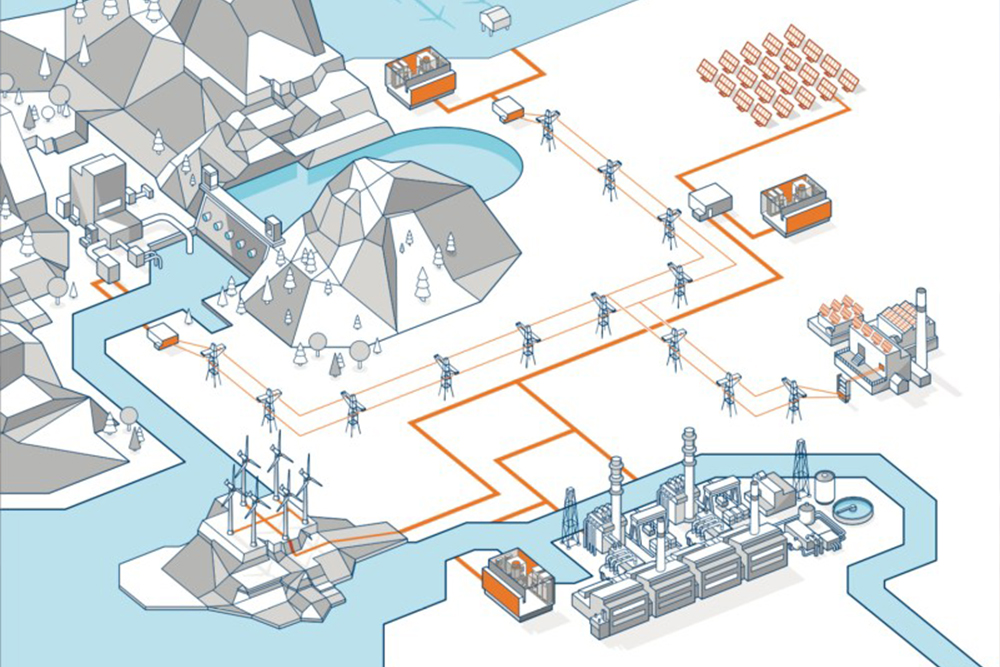Micro-Grid Program
What is Micro-grid
The components of the traditional power grid model include power generation companies, an aggregator, and users. Power generation companies sell electricity to an aggregator, and then an aggregator will then supply electricity to customers in the form of retail sales.
Typically the aggregator (also known as power companies) purchases electricity from power generation companies at lower prices and then sells them to users at higher prices. In turn, the users have to pay more as power companies turn a massive profit.
A micro-grid is a self-contained electrical network that allows you to generate your own electricity on-site and use it when you need it most.
It operates while connected to the grid, but importantly, it can break off and operate on its own using local energy generation in times of crisis like storms or power outages.
A micro-grid can be powered by distributed generators, batteries, and/or renewable resources like solar panels. Depending on how well it is maintained a micro-grid could run indefinitely.
It connects to the grid at a point of common coupling that maintains voltage at the same level as the main grid unless there is some sort of problem on the grid or other reason to disconnect.
In general, micro-grids have made it possible for power generation companies to provide power to users directly. The micro-grid has greatly weakened the role of electric grids and aggregators, thereby providing investors with more lucrative returns.


The components of electricity include power generation companies, electric grid, aggregator and users. Power generator sell electricity to aggregator, and aggregator will then supply electricity to customers in the form of retail sales.
Among them, power companies(aggregator) purchase power resources from power generation companies at lower prices, selling them to users at higher prices, and earn most of their profits.
However, the traditional Electric Power System model is prone to produce a series of power incidents including power outages, insufficient power supply, and spot markets(extremely high electric retail price).
Micro-grids improve reliability, resilience, and energy efficiency while integrating renewable sources and operating autonomously. Ideal for remote areas, campuses, industrial complexes, or regions with frequent grid outages; they provide tailored, sustainable energy solutions ensuring a consistent power supply where grid access is limited or unreliable.
The Australian Government has rolled out a range of programs to help industries, communities, and individuals manage their energy use and costs more effectively. Among these initiatives, the Micro-grid and Smart Grid program, managed by the Department of Industry, Innovation and Science (DIIS), stands out.
In Victoria, the state government is set to contribute up to $10 million over the next four years to fund projects based on micro-grid models. Meanwhile, over in Western Australia, the state government and Western Power are teaming up to develop a micro-grid aimed at boosting electricity reliability between the Geraldton and Kalbarri communities. Western Power is kicking things off with a $300,000 feasibility study to explore how best to support the 140km network connecting these regions.
While traditional power grids are generally reliable, they can suffer from catastrophic blackouts due to natural disasters or security breaches. To address this, micro-grids are being developed as resilient and flexible power systems that can operate independently or alongside the traditional grid. These systems are seen as efficient solutions for organisations and communities needing dependable energy, less risk of blackouts, lower costs, and a reduced reliance on fossil fuels.
With advances in battery technology, community-scale micro-grids could become cost-effective soon. Navigant Research predicts the energy storage market for micro-grids will grow from $662 million in 2014 to $4 billion by 2024.
One use of a micro-grid is for islands, mountains, and remote areas that are beyond the reach of traditional grids. They consist of photovoltaic or wind power stations, energy storage systems, and supplemental diesel generators. These systems require minimal electricity usage, involve a Power Purchase Agreement (PPA), and include a maintenance fee.
For this model new houses and/or communities with grid access are equipped with solar panels on roofs and in-home energy storage systems. Each energy storage system is then connected to a unified micro-grid which is supplemented with the traditional grid. This setup offers discounts on standard electricity rates and includes a fixed maintenance fee.
Virtual micro-grids suit apartment buildings, hotels, and offices. They use energy storage systems and photovoltaic power stations located remotely, integrating with end-user network points and supplemented with an external grid. This model offers discounts on standard electricity rates, with possible additional access fees.
Energy storage systems do more than support power in a micro-grid. They smooth out PV power fluctuations, regulate frequency and voltage at the utility level, and provide peak shaving and emergency backup at the consumer level. This ensures a continuous power supply even when primary energy sources are offline.
There are TWO ways to work with ACE:
Option 1: The ACE company invests in the project, providing electricity to the user. The user will then have a lower electricity price.
Or Option 2: ACE company acts as a contractor, responsible for EPC and project maintenance but the project itself is invested by the user.
Owning an electric vehicle alone doesn’t fully offset CO2 emissions. EVs reduce emissions only when charged with renewable energy, like solar. Charging your EV with solar power ensures that your driving is both cost effective and environmentally sustainable.

